英语语法教学微课教案(情态动词can和could)
情态动词的基本作法教案
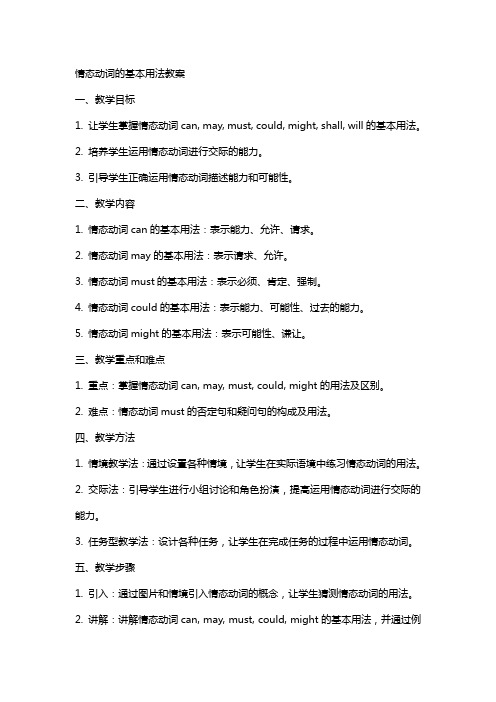
情态动词的基本用法教案一、教学目标1. 让学生掌握情态动词can, may, must, could, might, shall, will的基本用法。
2. 培养学生运用情态动词进行交际的能力。
3. 引导学生正确运用情态动词描述能力和可能性。
二、教学内容1. 情态动词can的基本用法:表示能力、允许、请求。
2. 情态动词may的基本用法:表示请求、允许。
3. 情态动词must的基本用法:表示必须、肯定、强制。
4. 情态动词could的基本用法:表示能力、可能性、过去的能力。
5. 情态动词might的基本用法:表示可能性、谦让。
三、教学重点和难点1. 重点:掌握情态动词can, may, must, could, might的用法及区别。
2. 难点:情态动词must的否定句和疑问句的构成及用法。
四、教学方法1. 情境教学法:通过设置各种情境,让学生在实际语境中练习情态动词的用法。
2. 交际法:引导学生进行小组讨论和角色扮演,提高运用情态动词进行交际的能力。
3. 任务型教学法:设计各种任务,让学生在完成任务的过程中运用情态动词。
五、教学步骤1. 引入:通过图片和情境引入情态动词的概念,让学生猜测情态动词的用法。
2. 讲解:讲解情态动词can, may, must, could, might的基本用法,并通过例句进行说明。
3. 练习:设计各种练习题,让学生区分情态动词的用法,如填空、选择、连词成句等。
4. 交际:组织小组讨论和角色扮演,让学生在实际语境中运用情态动词进行交际。
5. 任务:设计任务,如调查表、小作文等,让学生在完成任务的过程中运用情态动词。
6. 总结:对本节课的内容进行总结,强调情态动词的用法及区别。
7. 作业:布置作业,巩固所学内容,如练习题、观看相关视频等。
六、教学评估1. 课堂参与度:观察学生在课堂活动中的参与程度,了解他们对情态动词用法的掌握情况。
2. 练习完成情况:检查学生完成练习的情况,评估他们对情态动词用法的理解和应用能力。
情态动词can与could(教学设计)中考英语

情态动词can/could重/难点重点:了解并掌握情态动词can/could表示能力、表示许可、表示推测以及用于固定习语中。
难点:在语言实践中正确运用情态动词can/could表达态度与观点。
重/难点分析重点分析:can与could在口语中相当于may,表示许可,意思是“可以”。
could可以表示客气的请求,回答时用can,而不用could。
can 表示能力,意思为“能,会”,过去式是could。
其意义相当于be able to。
can和could表示推测,意为“可能,会”,主要用于否定句和疑问句中。
有时也用于肯定句中表示“有时会”,或表示理论上的可能性。
can’t/couldn’t help doing是习惯用语,意思是“忍不住做某事,情不自禁做某事”。
难点分析:情态动词can/could在肯定句和疑问句或否定句中所表达的意义有所不同,有时could并不是表示过去而是表达一种语气,这就给学习与运用带来困难。
因此,在语言实践中正确运用情态动词can/could 表达态度与观点是学习的难点。
突破策略1. 在导入阶段,为了生动、有趣地引出所学内容,可以采用视频的形式导入。
比如,教师可以选用视频《马达加斯加》中含有台词“We can do it! We can do anything! It's us!”的片段。
视频播放完毕,教师指出:句中can是情态动词。
情态动词can/could可以表示能力、表示许可、表示推测以及用于固定习语中。
下面通过例句一起来学习情态动词can/could的用法。
2. 在语言感悟阶段,教师可以设计一个整体情境,使语法学习在一定的语境下进行。
比如,教师可以根据电影《疯狂动物城》中兔子朱迪和狐狸尼克去车管所查车牌号时的情景,设计了朱迪和尼克与公务员树懒的对话,把所要学习的语言知识自然而然地融入到对话中,这样的设计符合课标的要求和学生的认知规律。
当然,在课堂教学过程中,教师要注重体现学生的主体地位,可以把学生分成不同的学习小组。
英语语法教学微课教案(情态动词can和could)

英语语法教学微课教案(情态动词can和could)第一篇:英语语法教学微课教案(情态动词can和could) 英语语法教学微课教案(情态动词can和could)一、Teaching Content: Topic:Unit 5 Can you play the guitar? Grammar:Using “can”/ “could” to talk about ability二、Teaching Aims: e can talk about the ability at e could talk about ability in the past.三、Teaching Key and Difficult Points: How to use “can” and “could” to express ability in the present and past.四、Teaching Methods: Task-Based Language Teaching Method五、Teaching Procedures: Step 1:Warming upTask 1: Revision T: What can you do now? S1: I can sing.S2: I can draw S3: I can dance.T: Can you ride a bike / swim / fly a kite / play football / play chess? Ss:Yes , I can./ No, I can’t.Task 2: Playing a game T: Now let us play a game.Five students come to the front and perform for to my instructions.and gestures.The others answer my questions.T : What can she do? Ss : She can ride a bike /swim/ fly a kite/ play football / play chess.T: Can she swim/ fly a kite/play football /play chess.Ss: Yes ,She can? No, she can’t.T: Say the whole sentences: eg: A can ride a bike.He can’t / cannot swim.Step 2: Presentation T: Can you ride a bike now? S1:Yes.I can T:Could you ride a bike five years ago ?Yes, I could./ No, I couldn’t(Help him answer)S1:Yes, I could./ No, I couldn’t.T: we can use “could” t talk about the past.e.g I can play computer now.But, last year I couldn’t play.T: Could you row a boat last year? S1:Yes I could.No, I couldn’t.T: Could she he row a boat last year?(Ask other students)Ss: Yes she he could.No she he couldn’t T:Yes , A could ride a bike five yearsago.He couldn’t swim five years ago.the class according(Teach the students to say the whole sentences): A could ride a bike five ye ars ago.He couldn’t swim five years ago.)(Ask other students in the same ways)Step 3: Practice :work in pairs T: Ask your partner more questions eg: Could he / she …?(Yes, he / she could./ No, he / she couldn’t.)...Step 4: Production Task 3: Explanation T: Let’s work out the rule.① 肯定句式: can could② 否定句式: can’t couldn’t③ 疑问句式: Can …?Could …?T: We can use “am(is , are)able to “ instead of “can”,and “was(were)able to “ instead of “could“.eg.①Mike can sing more than 20 English songs.Mike is able to …②She c ould speak English when she was four.She was able to…T: Please give more examples.to practice them.Step 5: Summary T:In this class, we have learnt the use of can and could about talking about abilities.Who knows the differences between “can” and “could” S tep 6: Homework Finish off the practice on the workbooks ,Fill in the blank with can/could第二篇:英语人教版八年级下册情态动词can和could微课教学设计初中英语语法教学微课教学设计(情态动词can和could)教学思路: 本节课我教的是情态动词can和could作“能力”解时的区别。
高中英语情态动词教学教案

情态动词一知识梳理can/could1:表示能力,翻译为能,会,可以。
两种时态can( could).can=be able to (can只有过去式could,be able to有多种时态)Translate:He can speak French.With our help, he was able to build the house.2: 表示请求或许可,could比can更加客气,翻译为“可以...吗?”此时可与may, might互换。
Can I go now? Yes, you can./ No, you can’t.Could I come to see you tomorrow? Yes, you can./ No, I’m afraid not.3:表示推测或可能性,常用于否定句或疑问句(could偶尔也会在肯定句中出现),翻译为“可能”。
此时could 只表示可能性比can小,而不表示时态。
Translate:Can he be at school? ___________________________He can’t be the thief. _____________________________Today is Sunday. He can’t be at school.___________________________4:can表示客观上的可能性,意为“有时会”,多用于肯定句。
Translate:Children can be noisy.________________________________It can be very hot in our city in summer.___________________________5: could have done可以表示虚拟语气。
could have done表示“本来可以做但没做”couldn’t have done 表示“过去不可能作某事”Translate:You are late again. You could have got up earlier.____________________may/might1:表示请求或允许,翻译为“可以”,在疑问句中might 比may的语气更委婉。
初中英语语法教学微课教案新部编本(情态动词can与could).doc

精品教学教案设计| Excellent teaching plan教师学科教案[ 20–20学年度第__学期]任教学科: _____________任教年级: _____________任教老师: _____________xx市实验学校精品教学教案设计| Excellent teaching plan 初中英语语法教学微课教案(情态动词can 和 could )汤山中学彭胜芳教学思路 :本节课我教的是情态动词can 和 could 作“能力”解时的区别。
这节课我打算通过复习以前学过的情态动词can 的用法,以及通过做游戏,让学生在轻松愉快的氛围中掌握can 的用法,以及了解can 和 could 的区别。
一、 Teaching Content:Unit 3Can you play the guitar?Grammar:Using “can”/“could” to talk about ability二、 Teaching Aims:e can talk about the ability at present.e could talk about ability in the past.三、 Teaching Key and Difficult Points:Howto use “can”and “could ”to express ability in the present and past.四、 Teaching Methods:Task-Based Language Teaching Method五、 Teaching Procedures:Step 1 :Warming upTask 1: RevisionT: What can you do now?精品教学教案设计| Excellent teaching planS1: I can sing.S2: I can drawS3: I can dance.T:Can you ride a bike / swim / fly a kite / play football/play chess?Ss:Yes , I can. / No, I can’t.Task 2: Playing a gameT: Now let us play a game. Five students come to the front and perform for the class according to my instructions.and gestures.The others answer my questions.T : What can she do?Ss : She can ride a bike /swim/ fly a kite/ play football/ play chess .T: Can she swim/ fly a kite/play football /play chess.Ss: Yes ,She can? No, she can’t.T: Say the whole sentences:eg: A can ride a bike.He can ’t / cannot swim.Step 2: PresentationT: Can you ride a bike now?S1:Yes. I canT:-Could you ride a bike five years ago ?-Yes, I could./ No, I couldn’t( Help him answer)S1:Yes, I could./ No, I couldn’t.T: we can use“could” t talk about the paste.g I can play computer now .But, last year I couldn’tplay.T: Could you row a boat last year?S1:Yes I could . No, I couldn’t.T: Could she he row a boat last year?( Ask other students)Ss: Yes she he could . No she he couldn’tT:Yes , A could ride a bike five years ago.He couldn ’t swim five years ago.(Teach the students to say the whole sentences):A could ride a bike five years ago.He couldn ’t swim five years ago.)(Ask other students in the same ways)Step 3:Practice :work in pairsT: Ask your partner more questionseg: Could he / she⋯?(Yes, he / she could. / No, he / she couldn’t.) ...Step4: ProductionTask 3: ExplanationT: Let ’s work out the rule.①肯定句式 : can\ could②否定句式 : can ’t\ couldn’t③疑句式 : Can⋯?\Could⋯?T: Wecan use “am(is , are) able to “ instead of “can”,and “was (were) able to“ instead of“could“.eg. ①Mike can sing more than 20 English songs.Mike is able to⋯②S he could speak English when she was four.She was able to⋯T:Please give more examples.to practice them.Step 5: SummaryT:In this class, we have learnt the use of can and could about talking about abilities .Who knows the differences between “can” and“could ”Step 6:HomeworkFinish off the practice on the workbooks ,Fill in the blank with can/could。
〖2021年整理〗《语法精讲情态动词can与could》优秀教案
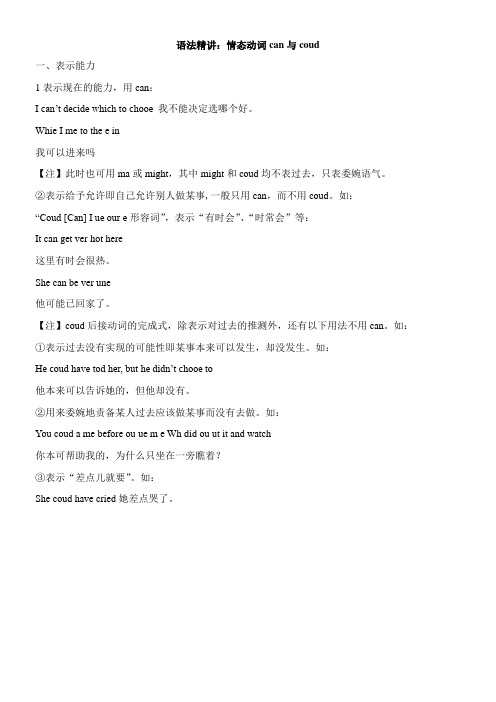
语法精讲:情态动词can与coud
一、表示能力
1表示现在的能力,用can:
I can’t decide which to chooe 我不能决定选哪个好。
Whie I me to the e in
我可以进来吗
【注】此时也可用ma或might,其中might和coud均不表过去,只表委婉语气。
②表示给予允许即自己允许别人做某事,一般只用can,而不用coud。
如:
“Coud [Can] I ue our e形容词”,表示“有时会”、“时常会”等:
It can get ver hot here
这里有时会很热。
She can be ver une
他可能已回家了。
【注】coud后接动词的完成式,除表示对过去的推测外,还有以下用法不用can。
如:①表示过去没有实现的可能性即某事本来可以发生,却没发生。
如:
He coud have tod her, but he didn’t chooe to
他本来可以告诉她的,但他却没有。
②用来委婉地责备某人过去应该做某事而没有去做。
如:
You coud a me before ou ue m e Wh did ou ut it and watch
你本可帮助我的,为什么只坐在一旁瞧着?
③表示“差点儿就要”。
如:
She coud have cried她差点哭了。
情态动词 教学设计
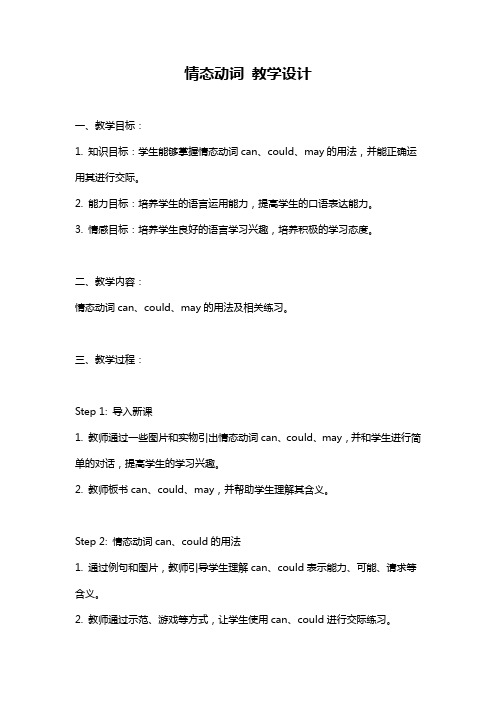
情态动词教学设计一、教学目标:1. 知识目标:学生能够掌握情态动词can、could、may的用法,并能正确运用其进行交际。
2. 能力目标:培养学生的语言运用能力,提高学生的口语表达能力。
3. 情感目标:培养学生良好的语言学习兴趣,培养积极的学习态度。
二、教学内容:情态动词can、could、may的用法及相关练习。
三、教学过程:Step 1: 导入新课1. 教师通过一些图片和实物引出情态动词can、could、may,并和学生进行简单的对话,提高学生的学习兴趣。
2. 教师板书can、could、may,并帮助学生理解其含义。
Step 2: 情态动词can、could的用法1. 通过例句和图片,教师引导学生理解can、could表示能力、可能、请求等含义。
2. 教师通过示范、游戏等方式,让学生使用can、could进行交际练习。
Step 3: 情态动词may的用法1. 教师通过例句和图片,教学may表示允许、可能、祝愿等含义。
2. 教师通过示范、游戏等方式,让学生使用may进行交际练习。
Step 4: 情态动词用法的区别1. 教师通过对比can、could、may的用法,帮助学生理解它们的区别。
2. 教师设计练习题目,让学生运用所学的知识进行区分。
Step 5: 情态动词用法的拓展1. 教师通过例句和图片,教学情态动词can、could、may的其他用法,如推测、建议、义务等。
2. 教师设计练习题目,让学生巩固并运用所学的知识。
Step 6: 综合练习1. 教师设计综合练习题目,让学生运用所学的知识进行综合练习。
2. 学生完成练习并进行互评。
四、教学设计说明:1. 通过情景教学法,引发学生兴趣,培养学生的学习动力。
2. 设计合适的示范和练习活动,激发学生的参与热情,培养学生的语言运用能力。
3. 教师做好情态动词用法的讲解和示范,帮助学生理解并运用所学知识。
4. 教师通过综合练习的设置,提高学生的综合运用能力。
英语语法教学微课教案(情态动词can和could)

英语语法教学微课教案(情态动词can和could)第一章:情态动词can和could的概述1.1 情态动词can的用法表示能力表示可能性表示允许1.2 情态动词could的用法表示过去的能力表示可能性表示礼貌的请求第二章:情态动词can和could的构成和发音2.1 情态动词can的构成和发音构成:can + 动词原形发音:[kæn]2.2 情态动词could的构成和发音构成:could + 动词原形发音:[kʊd]第三章:情态动词can和could的肯定句和否定句3.1 情态动词can的肯定句和否定句肯定句:主语+ can + 动词原形+ 其他否定句:主语+ can't + 动词原形+ 其他3.2 情态动词could的肯定句和否定句肯定句:主语+ could + 动词原形+ 其他否定句:主语+ couldn't + 动词原形+ 其他第四章:情态动词can和could的疑问句4.1 情态动词can的疑问句疑问句:Can + 主语+ 动词原形+ 其他?4.2 情态动词could的疑问句疑问句:Could + 主语+ 动词原形+ 其他?第五章:情态动词can和could的实战练习5.1 能力练习编写句子,用情态动词can表示能力。
编写句子,用情态动词could表示过去的能力。
5.2 可能性练习编写句子,用情态动词can表示可能性。
编写句子,用情态动词could表示可能性。
5.3 允许练习编写句子,用情态动词can表示允许。
编写句子,用情态动词could表示礼貌的请求。
第六章:情态动词can和could的常用短语6.1 情态动词can的常用短语be able to:能够can't wt to:迫不及待can't help but:禁不住can't stand:无法忍受6.2 情态动词could的常用短语could be:可能是could have:本可以做could try:可以尝试could you please:请问可以吗第七章:情态动词can和could的时态配合7.1 情态动词can的时态配合can + 现在时态:表示一般现在时can + 过去时态:表示一般过去时can + 将来时态:表示一般将来时7.2 情态动词could的时态配合could + 现在时态:表示过去的能力could + 过去时态:表示过去过去时could + 将来时态:表示过去将来时第八章:情态动词can和could的对比分析8.1 情态动词can和could的用法对比can表示现在的能力、可能性、允许;could表示过去的能力、可能性、礼貌的请求。
高中英语新人教版精品教案《情态动词之can和could的用法》
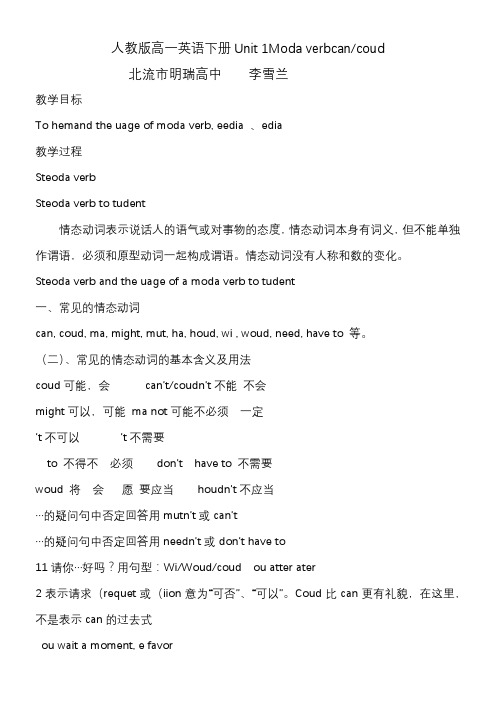
人教版高一英语下册Unit 1Moda verbcan/coud北流市明瑞高中李雪兰教学目标To hemand the uage of moda verb, eedia 、edia教学过程Steoda verbSteoda verb to tudent情态动词表示说话人的语气或对事物的态度,情态动词本身有词义,但不能单独作谓语,必须和原型动词一起构成谓语。
情态动词没有人称和数的变化。
Steoda verb and the uage of a moda verb to tudent一、常见的情态动词can, coud, ma, might, mut, ha, houd, wi , woud, need, have to 等。
(二)、常见的情态动词的基本含义及用法coud可能,会can’t/coudn’t不能不会might可以,可能ma not可能不必须一定’t不可以’t不需要to 不得不必须don’t have to 不需要woud 将会愿要应当houdn’t不应当…的疑问句中否定回答用mutn’t或can’t…的疑问句中否定回答用needn’t或don’t have to11请你…好吗?用句型:Wi/Woud/coud ou atter ater2表示请求(requet或(iion意为“可否”、“可以”。
Coud比can更有礼貌,在这里,不是表示can的过去式ou wait a moment, e favorme,coud ou te me the wa to the tationWonder if ou coud heerequetou thin I coud borrow our bieiion3can/coud have done 结构表示对过去发生的事情的“怀疑”或“不肯定”,用于问句或否定句。
Coud have done 用于肯定句时,一般表示“过去本来能完成而未完成的动作”。
Who coud/can have taen m new , but ou were too caree虚拟)4Cannot heuchCannot heeworDo ome eercie about can and coud。
2022年教学教材《情态动词can和could的用法和区别》优秀教案

情态动词can, coud的用法和区别一、情态动词can的用法1 表示能力,意思是:能,会。
如:I can't wim 我不会游泳。
Can ou drive?你会开车吗?2 表示客观可能性,意思是:可以,可能。
如:That big cinema can eat 2,000 e earier, if necear 如果必要我可以早点来。
这时coud和can没有时间上的差异。
4 在虚拟条件句中构成谓语。
如:I woud certain do it for ou if I coud 要是我能做得到,我一定会为你们做这事儿。
How I wih I coud go with ou! 我多么希望和你们一道去!三、can, coud 和be abe to的区别与联系。
1 can的过去式是coud,但coud 除了可作can的过去式外,还可表比can 更委婉的语气,因此在答复由coud 表示请求的问句中,不能用coud,但可用can。
如:—Coud ou end me a hand—Of coure I can2 在表示现在或过去的智力、体力、技能等方面的“能力〞时,can, coud 常可与be abe to互换。
如:He coud or wa abe to wim five mie when he wa a bo3 be abe to有比can更多的形式,如"wi be abe to","have ha been abe to" "had been abe to" 等等。
因此be abe to常被用来表示can所不能表示的将来或完成的概念。
如:The wi be abe to run thi machine on their own in three month 他们过三个月就能自己开这台机器了。
4 在表示成功地做了某事时,不用coud,而用wa / were abe to 或managed to, ucceeded in doing th 来表示。
英语语法教学微课教案(情态动词can和could)

英语语法教学微课教案(情态动词can和could)一、教学目标1. 让学生掌握情态动词can和could的用法。
2. 培养学生运用情态动词进行日常交流的能力。
3. 提高学生对英语语法的兴趣和自信心。
二、教学内容1. can和could的基本用法。
2. can和could在不同情境下的应用。
3. 练习和巩固所学知识。
三、教学重点与难点1. 重点:can和could的用法及区别。
2. 难点:如何正确运用can和could进行日常交流。
四、教学方法1. 情境教学法:通过设定不同的情境,让学生在实际语境中学习、理解和运用can和could。
2. 任务型教学法:通过完成各种任务,培养学生的实际运用能力。
3. 互动式教学法:鼓励学生积极参与,提高课堂氛围。
五、教学过程1. 引入:通过一个简单的日常交流场景,引导学生思考情态动词的作用。
2. 讲解:讲解can和could的基本用法,并举例说明。
3. 练习:让学生进行小组练习,运用can和could进行交流。
4. 情境模拟:设置不同情境,让学生扮演角色,运用can和could 进行对话。
5. 任务完成:让学生分组完成一项任务,如编写一个小故事,运用can和could。
6. 总结与反馈:对学生的表现进行点评,指出优点和不足,鼓励学生继续努力。
7. 拓展练习:布置课后作业,让学生进一步巩固所学知识。
8. 课堂小结:总结本节课的主要内容,强调can和could的用法及区别。
9. 课后反思:教师对本节课的教学效果进行反思,为下一节课做好准备。
六、教学评价1. 学生能熟练运用can和could进行日常交流。
2. 学生能正确完成相关练习和任务。
3. 学生对英语语法的兴趣和自信心有所提高。
七、教学资源1. PPT课件:展示can和could的用法及例句。
2. 情境模拟道具:如图片、卡片等。
3. 小组活动材料:如故事编写模板、任务清单等。
八、教学步骤1. 引入:通过一个简单的日常交流场景,引导学生思考情态动词的作用。
情态动词的基本作法教案
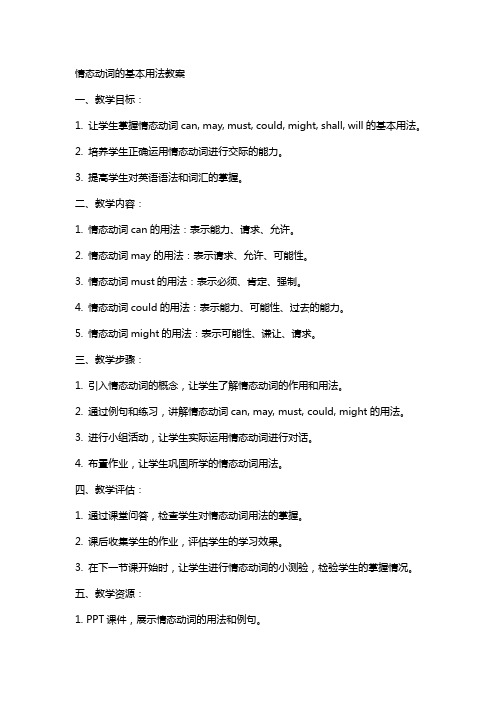
情态动词的基本用法教案一、教学目标:1. 让学生掌握情态动词can, may, must, could, might, shall, will的基本用法。
2. 培养学生正确运用情态动词进行交际的能力。
3. 提高学生对英语语法和词汇的掌握。
二、教学内容:1. 情态动词can的用法:表示能力、请求、允许。
2. 情态动词may的用法:表示请求、允许、可能性。
3. 情态动词must的用法:表示必须、肯定、强制。
4. 情态动词could的用法:表示能力、可能性、过去的能力。
5. 情态动词might的用法:表示可能性、谦让、请求。
三、教学步骤:1. 引入情态动词的概念,让学生了解情态动词的作用和用法。
2. 通过例句和练习,讲解情态动词can, may, must, could, might的用法。
3. 进行小组活动,让学生实际运用情态动词进行对话。
4. 布置作业,让学生巩固所学的情态动词用法。
四、教学评估:1. 通过课堂问答,检查学生对情态动词用法的掌握。
2. 课后收集学生的作业,评估学生的学习效果。
3. 在下一节课开始时,让学生进行情态动词的小测验,检验学生的掌握情况。
五、教学资源:1. PPT课件,展示情态动词的用法和例句。
2. 练习题,巩固情态动词的用法。
3. 小组活动指导,帮助学生进行实际操作。
4. 作业布置,让学生巩固所学知识。
六、教学扩展:1. 引入情态动词shall和will的用法:表示将来、承诺、警告。
2. 通过例句和练习,讲解情态动词shall和will的用法。
3. 进行情景模拟,让学生实际运用情态动词shall和will进行对话。
七、课堂活动:1. 组织一个情态动词的角色扮演活动,让学生在具体情境中运用所学的情态动词。
2. 鼓励学生创造性地运用情态动词,展示他们的语言运用能力。
3. 邀请学生分享他们在活动中遇到的问题和解决方法,促进师生互动。
八、教学反思:2. 分析学生的学习情况,了解学生的掌握程度。
英语语法教学微课教案(情态动词can和could)
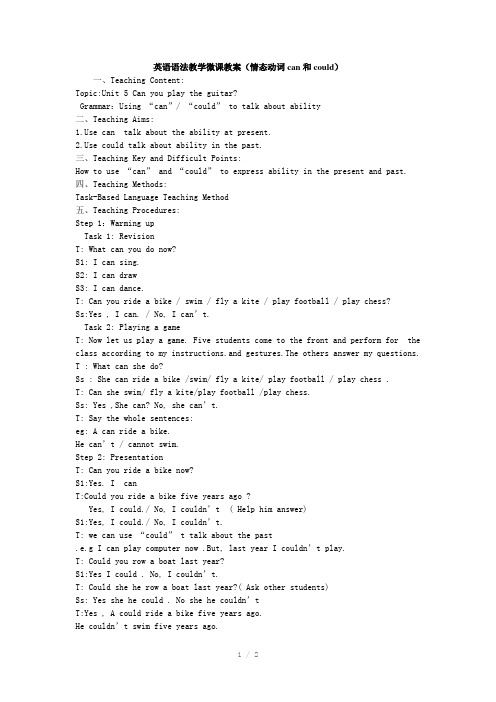
英语语法教学微课教案(情态动词can和could)一、Teaching Content:Topic:Unit 5 Can you play the guitar?Grammar:Using “can”/ “could” to talk about ability二、Teaching Aims:e can talk about the ability at present.e could talk about ability in the past.三、Teaching Key and Difficult Points:How to use “can” and “could” to express ability in the present and past.四、Teaching Methods:Task-Based Language Teaching Method五、Teaching Procedures:Step 1:Warming upTask 1: RevisionT: What can you do now?S1: I can sing.S2: I can drawS3: I can dance.T: Can you ride a bike / swim / fly a kite / play football / play chess?Ss:Yes , I can. / No, I can’t.Task 2: Playing a gameT: Now let us play a game. Five students come to the front and perform for the class according to my instructions.and gestures.The others answer my questions. T : What can she do?Ss : She can ride a bike /swim/ fly a kite/ play football / play chess .T: Can she swim/ fly a kite/play football /play chess.Ss: Yes ,She can? No, she can’t.T: Say the whole sentences:eg: A can ride a bike.He can’t / cannot swim.Step 2: PresentationT: Can you ride a bike now?S1:Yes. I canT:Could you ride a bike five years ago ?Yes, I could./ No, I couldn’t ( Help him answer)S1:Yes, I could./ No, I couldn’t.T: we can use “could” t talk about the past.e.g I can play computer now .But, last year I couldn’t play.T: Could you row a boat last year?S1:Yes I could . No, I couldn’t.T: Could she he row a boat last year?( Ask other students)Ss: Yes she he could . No she he couldn’tT:Yes , A could ride a bike five years ago.He couldn’t swim five years ago.1 / 2(Teach the students to say the whole sentences):A could ride a bike five years ago.He couldn’t swim five years ago.)(Ask other students in the same ways)Step 3: Practice :work in pairsT: Ask your partner more questionseg: Could he / she …?(Yes, he / she could. / No, he / she couldn’t.)...Step 4: ProductionTask 3: ExplanationT: Let’s work out the rule.①肯定句式: can\ could②否定句式: can’t\ couldn’t③疑问句式: Can …?\Could …?T: We can use “am (is , are) able to “ instead of “can”,and “was (were) able to “ instead of “could“.eg.①Mike can sing more than 20 English songs.Mike is able to …②She could speak English when she was four.She was able to…T: Please give more examples.to practice them.Step 5: SummaryT:In this class, we have learnt the use of can and could about talking about abilities .Who knows the differences between “can” and “could”Step 6: HomeworkFinish off the practice on the workbooks ,Fill in the blank with can/could。
情态动词的基本作法教案

情态动词的基本用法教案一、教学目标1. 让学生掌握情态动词can, may, must, could, might, should 的基本用法。
2. 培养学生运用情态动词进行日常交流的能力。
3. 提高学生对英语语法和词汇的理解。
二、教学内容1. 情态动词can 的用法:表示能力、允许、请求、可能性等。
2. 情态动词may 的用法:表示请求、允许、可能性等。
3. 情态动词must 的用法:表示肯定、必须、推测等。
4. 情态动词could 的用法:表示过去的能力、请求、可能性等。
5. 情态动词might 的用法:表示可能性、请求、谦让等。
6. 情态动词should 的用法:表示应该、建议、可能性等。
三、教学重点与难点1. 重点:掌握情态动词can, may, must, could, might, should 的基本用法。
2. 难点:区分情态动词之间的用法和搭配,以及在不同语境中的运用。
四、教学方法1. 任务型教学法:通过小组讨论、角色扮演等任务,让学生在实际语境中运用情态动词。
2. 情境教学法:创设各种真实的情境,让学生在实践中学会使用情态动词。
3. 互动式教学法:引导学生积极参与课堂活动,提高课堂氛围,增强学生的学习兴趣。
五、教学步骤1. 导入:以一段对话引入情态动词的概念,激发学生的学习兴趣。
2. 讲解:分别讲解情态动词can, may, must, could, might, should 的基本用法。
3. 练习:设计不同情境的练习题,让学生运用所学情态动词进行回答。
4. 小组讨论:让学生分组讨论情态动词在不同情境下的用法,分享学习心得。
5. 角色扮演:分组进行角色扮演,模拟真实场景,运用情态动词进行交流。
6. 总结:对本节课所学内容进行总结,强调情态动词的用法和搭配。
7. 作业:布置相关练习题,巩固所学知识。
六、教学评估1. 课堂练习:观察学生在练习中的表现,了解他们对于情态动词用法的掌握情况。
英语情态动词的用法教案
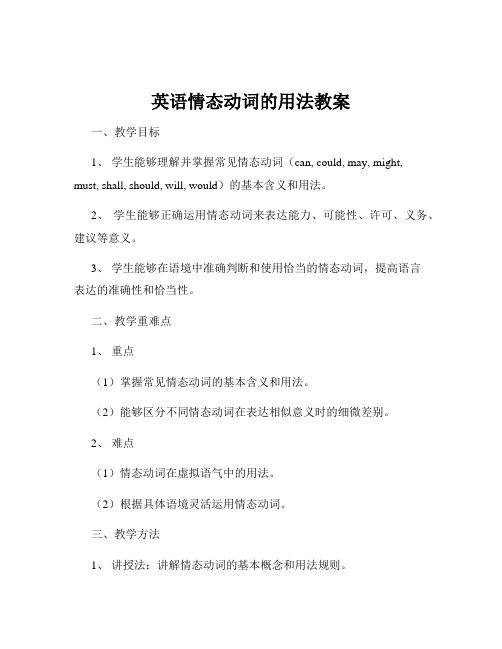
英语情态动词的用法教案一、教学目标1、学生能够理解并掌握常见情态动词(can, could, may, might, must, shall, should, will, would)的基本含义和用法。
2、学生能够正确运用情态动词来表达能力、可能性、许可、义务、建议等意义。
3、学生能够在语境中准确判断和使用恰当的情态动词,提高语言表达的准确性和恰当性。
二、教学重难点1、重点(1)掌握常见情态动词的基本含义和用法。
(2)能够区分不同情态动词在表达相似意义时的细微差别。
2、难点(1)情态动词在虚拟语气中的用法。
(2)根据具体语境灵活运用情态动词。
三、教学方法1、讲授法:讲解情态动词的基本概念和用法规则。
2、练习法:通过练习题巩固所学知识。
3、情景教学法:创设具体情境,让学生在实际情境中运用情态动词。
四、教学过程1、导入(5 分钟)通过展示一些包含情态动词的句子,如“I can swim” “You must finish your homework on time” 等,引导学生观察这些句子,提问学生对这些句子中情态动词的理解,从而引出本节课的主题——英语情态动词的用法。
2、知识讲解(25 分钟)(1)Can 和 couldCan 表示能力、可能性、许可等。
例如:“I can speak English”(能力)“It can rain tomorrow”(可能性)“You can go now”(许可) Could 是 can 的过去式,用于过去时态中,但 could 也可以用于现在时态,语气比 can 更加委婉。
例如:“Could you help me?” (委婉请求)(2)May 和 mightMay 表示许可、可能性。
例如:“May I come in?” (许可)“It may be sunny tomorrow” (可能性)Might 是 may 的过去式,语气比 may 更加不确定和委婉。
英语语法教学微课教案(情态动词can和could)
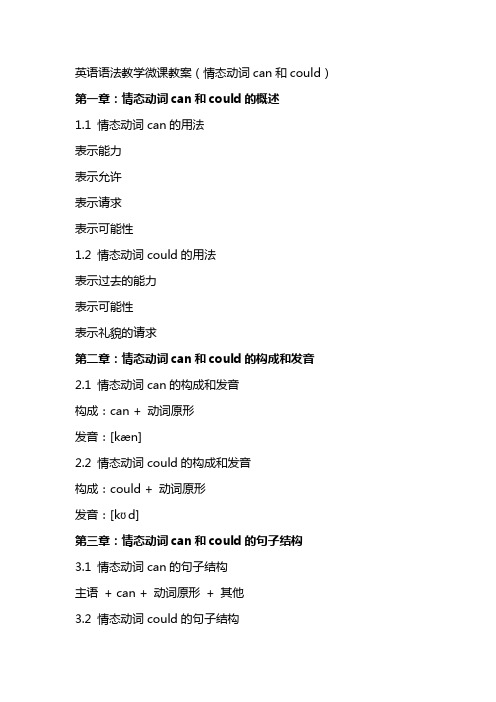
英语语法教学微课教案(情态动词can和could)第一章:情态动词can和could的概述1.1 情态动词can的用法表示能力表示允许表示请求表示可能性1.2 情态动词could的用法表示过去的能力表示可能性表示礼貌的请求第二章:情态动词can和could的构成和发音2.1 情态动词can的构成和发音构成:can + 动词原形发音:[kæn]2.2 情态动词could的构成和发音构成:could + 动词原形发音:[kʊd]第三章:情态动词can和could的句子结构3.1 情态动词can的句子结构主语+ can + 动词原形+ 其他3.2 情态动词could的句子结构主语+ could + 动词原形+ 其他第四章:情态动词can和could的举例练习4.1 能力方面的举例I can swim.She can speak English.4.2 允许方面的举例You can e in.They can't watch the movie.4.3 请求方面的举例Could you help me?Can you pass the salt?4.4 可能性方面的举例It can rn today.There could be a traffic jam.第五章:情态动词can和could的运用5.1 情态动词can的运用日常生活中表示能力、允许、请求和可能性。
5.2 情态动词could的运用过去表示能力、可能性、礼貌请求。
第六章:情态动词can和could的时态搭配6.1 情态动词can的时态搭配can + 动词原形:一般现在时could + 动词原形:一般过去时6.2 情态动词could的时态搭配could + 动词原形:过去能力、可能性、礼貌请求第七章:情态动词can和could的否定句7.1 情态动词can的否定句主语+ can't + 动词原形+ 其他主语+ cannot + 动词原形+ 其他7.2 情态动词could的否定句主语+ couldn't + 动词原形+ 其他主语+ could not + 动词原形+ 其他第八章:情态动词can和could的疑问句8.1 情态动词can的疑问句Could + 主语+ 动词原形+ 其他?Can + 主语+ 动词原形+ 其他?8.2 情态动词could的疑问句Could + 主语+ 动词原形+ 其他?Can + 主语+ 动词原形+ 其他?第九章:情态动词can和could的转移句型9.1 情态动词can的转移句型主体句:主语+ can + 动词原形宾语从句:主语+ can + that/if + 宾语从句9.2 情态动词could的转移句型主体句:主语+ could + 动词原形宾语从句:主语+ could + that/if + 宾语从句第十章:情态动词can和could的综合练习10.1 情景对话练习设计不同场景,让学生运用情态动词can和could进行对话。
- 1、下载文档前请自行甄别文档内容的完整性,平台不提供额外的编辑、内容补充、找答案等附加服务。
- 2、"仅部分预览"的文档,不可在线预览部分如存在完整性等问题,可反馈申请退款(可完整预览的文档不适用该条件!)。
- 3、如文档侵犯您的权益,请联系客服反馈,我们会尽快为您处理(人工客服工作时间:9:00-18:30)。
英语语法教学微课教案(情态动词can和could)
一、Teaching Content:
Topic:Unit 5 Can you play the guitar?
Grammar:Using “can”/ “could”to talk about ability
二、Teaching Aims:
e can talk about the ability at present.
e could talk about ability in the past.
三、Teaching Key and Difficult Points:
How to use “can” and “could” to express ability in the present and past.
四、Teaching Methods:
Task-Based Language Teaching Method
五、Teaching Procedures:
Step 1:Warming up
Task 1: Revision
T: What can you do now?
S1: I can sing.
S2: I can draw
S3: I can dance.
T: Can you ride a bike / swim / fly a kite / play football / play chess?
Ss:Yes , I can. / No, I can’t.
Task 2: Playing a game
T: Now let us play a game. Five students come to the front and perform for the class according to my instructions.and gestures.The others answer my questions.
T : What can she do?
Ss : She can ride a bike /swim/ fly a kite/ play football / play chess .
T: Can she swim/ fly a kite/play football /play chess.
Ss: Yes ,She can? No, she can’t.
T: Say the whole sentences:
eg: A can ride a bike.
He can’t / cannot swim.
Step 2: Presentation
T: Can you ride a bike now?
S1:Yes. I can
T:Could you ride a bike five years ago ?
Yes, I could./ No, I couldn’t ( Help him answer)
S1:Yes, I could./ No, I couldn’t.
T: we can use “could” t talk about the past
.e.g I can play computer now .But, last year I couldn’t play.
T: Could you row a boat last year?
S1:Yes I could . No, I couldn’t.
T: Could she he row a boat last year?( Ask other students)
Ss: Yes she he could . No she he couldn’t
T:Yes , A could ride a bike five years ago.
He couldn’t swim five years ago.
(Teach the students to say the whole sentences):
A could ride a bike five years ago.
He couldn’t swim five years ago.)
(Ask other students in the same ways)
Step 3: Practice :work in pairs
T: Ask your partner more questions
eg: Could he / she …?
(Yes, he / she could. / No, he / she couldn’t.)
...
Step 4: Production
Task 3: Explanation
T: Let’s work out the rule.
①肯定句式: can\ could
②否定句式: can’t\ couldn’t
③疑问句式: Can …?\Could …?
T: We can use “am (is , are) able to “ instead of “can”,and “was (were) able to “ instead of “could“.
eg.①Mike can sing more than 20 English songs.
Mike is able to …
②She could speak English when she was four.
She was able to…
T: Please give more examples.to practice them.
Step 5: Summary
T:In this class, we have learnt the use of can and could about talking about abilities .Who knows the differences between “can”and “could”
Step 6: Homework
Finish off the practice on the workbooks ,Fill in the blank with can/could。
